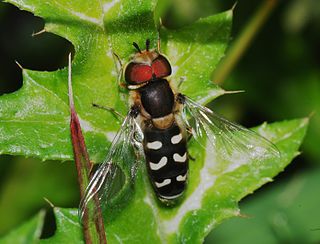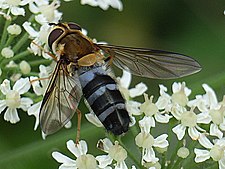
Eristalis is a large genus of hoverflies, family Syrphidae, in the order Diptera. Several species are known as drone flies because they bear a resemblance to honeybee drones. Drone flies and their relatives are fairly common generalist pollinators, the larvae of which are aquatic, and breathe through a long, snorkel-like appendage, hence the common name rat-tailed maggots.

Helix lucorum is a species of large, edible, air-breathing land snail, a terrestrial pulmonate gastropod mollusk in the family Helicidae, the typical snails.

Syrphus is a genus of hoverflies. It can be distinguished from other genera of the tribe Syrphini because it is the only genus that has long hairs on the upper surface of the lower lobe of the calypter.

Xylota is a Holarctic genus of hoverflies similar in structure to the related genera Chalcosyrphus and Brachypalpoides. As the larvae are saprophytic in rotting wood the adult flies are generally found associated with woodland and woodland edges and can often be seen running over the upper sides of leaves. Unlike other syrphids the adults of many species rarely visit flowers preferring instead to gather pollen from leaf surfaces. There are over 100 described species of which 12 can be found in Europe. Seven species have been recorded in Britain.

Myathropa is a European and North African genus of very common hoverfly. Adults may be seen on flowers from May to September. Larvae feed on bacteria in organic waterlogged detritus, often in the shallow rot holes of tree stumps.

Leucozona glaucia is a Palearctic hoverfly. Larvae feed on ground layer aphids. Adults are usually seen visiting flowers.

Temnostoma is a genus of hoverflies. The larvae of some species feed on the wood of deciduous trees.

Chrysotoxum is a genus of hoverflies.

Leucozona laternaria is a European species of hoverfly.

Leucozona lucorum is a Palearctic and Nearctic species of hoverfly.

Scaeva is a genus of hoverflies.

Sphaerophoria is a genus of hoverflies.

Blera is a genus of hoverflies. It is primarily a North American genus, though there are 3 species from Europe.

Anasimyia is a genus of wetland hoverflies with aquatic larvae. The genus is often regarded as a subgenus of the similar Lejops.

Pipiza is a genus Hoverflies, from the family Syrphidae, in the order Diptera. Most are dark hoverflies.
In the 10th edition of Systema Naturae, Carl Linnaeus classified the arthropods, including insects, arachnids and crustaceans, among his class "Insecta". Insects with simply two wings were brought together under the name Diptera.

Megasyrphus is a genus of hoverflies in the subfamily Syrphinae. It was formally a subgenus of Eriozona.



















